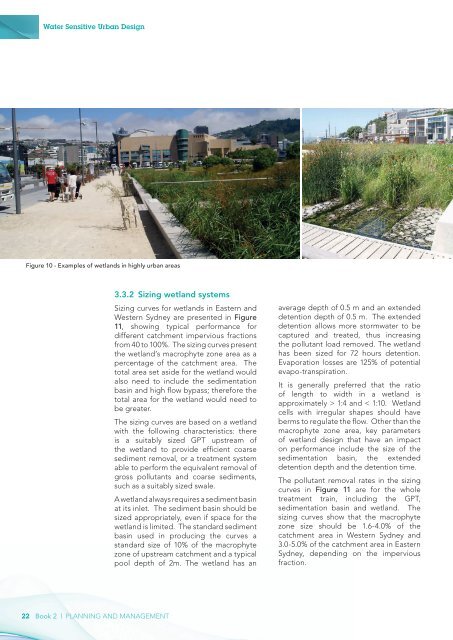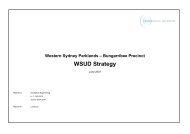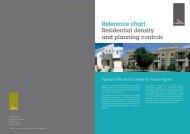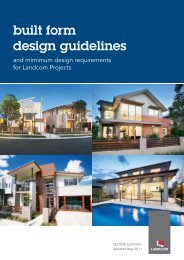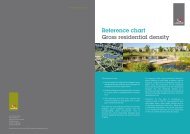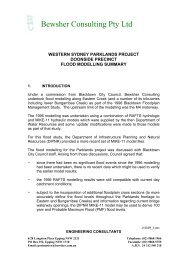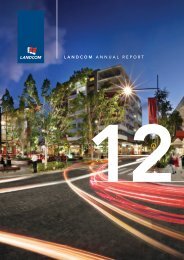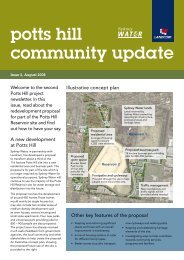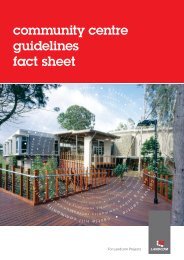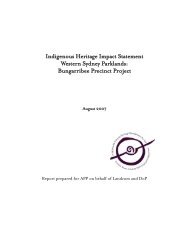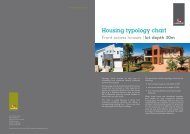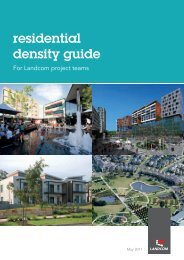Water Sensitive Urban Design
Book 2 | Planning and Management - WSUD
Book 2 | Planning and Management - WSUD
- No tags were found...
Create successful ePaper yourself
Turn your PDF publications into a flip-book with our unique Google optimized e-Paper software.
<strong>Water</strong> <strong>Sensitive</strong> <strong>Urban</strong> <strong>Design</strong><br />
Figure 10 - Examples of wetlands in highly urban areas<br />
3.3.2 Sizing wetland systems<br />
Sizing curves for wetlands in Eastern and<br />
Western Sydney are presented in Figure<br />
11, showing typical performance for<br />
different catchment impervious fractions<br />
from 40 to 100%. The sizing curves present<br />
the wetland’s macrophyte zone area as a<br />
percentage of the catchment area. The<br />
total area set aside for the wetland would<br />
also need to include the sedimentation<br />
basin and high flow bypass; therefore the<br />
total area for the wetland would need to<br />
be greater.<br />
The sizing curves are based on a wetland<br />
with the following characteristics: there<br />
is a suitably sized GPT upstream of<br />
the wetland to provide efficient coarse<br />
sediment removal, or a treatment system<br />
able to perform the equivalent removal of<br />
gross pollutants and coarse sediments,<br />
such as a suitably sized swale.<br />
A wetland always requires a sediment basin<br />
at its inlet. The sediment basin should be<br />
sized appropriately, even if space for the<br />
wetland is limited. The standard sediment<br />
basin used in producing the curves a<br />
standard size of 10% of the macrophyte<br />
zone of upstream catchment and a typical<br />
pool depth of 2m. The wetland has an<br />
average depth of 0.5 m and an extended<br />
detention depth of 0.5 m. The extended<br />
detention allows more stormwater to be<br />
captured and treated, thus increasing<br />
the pollutant load removed. The wetland<br />
has been sized for 72 hours detention.<br />
Evaporation losses are 125% of potential<br />
evapo-transpiration.<br />
It is generally preferred that the ratio<br />
of length to width in a wetland is<br />
approximately > 1:4 and < 1:10. Wetland<br />
cells with irregular shapes should have<br />
berms to regulate the flow. Other than the<br />
macrophyte zone area, key parameters<br />
of wetland design that have an impact<br />
on performance include the size of the<br />
sedimentation basin, the extended<br />
detention depth and the detention time.<br />
The pollutant removal rates in the sizing<br />
curves in Figure 11 are for the whole<br />
treatment train, including the GPT,<br />
sedimentation basin and wetland. The<br />
sizing curves show that the macrophyte<br />
zone size should be 1.6-4.0% of the<br />
catchment area in Western Sydney and<br />
3.0-5.0% of the catchment area in Eastern<br />
Sydney, depending on the impervious<br />
fraction.<br />
22 Book 2 | planning and management


